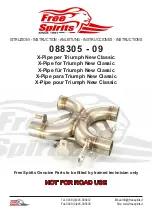
17 (32)
Disconnecting hydraulic hoses:
Before disconnecting the fittings, lower the attachment to safe position on solid and level surface. Turn the
control lever of the auxiliary hydraulics to its neutral position.
WARNING
Risk of tipping over - Ensure stability of the equipment.
Before disconnecting the
hydraulic hoses, set the backhoe to a stable storage position, see page
When uncoupling the attachment, always disconnect the hydraulic couplings before
unlocking the quick coupling plate, to prevent hose damage and any oil spills. Reinstall
the protective caps on the fittings to prevent impurities from entering the hydraulic
system.
Releasing residual hydraulic pressure:
In case residual pressure is left in the hydraulic system of the attachment, it is often possible to disconnect the
hydraulic couplings, but it may be difficult to connect them the next time. If the fittings will not connect, the
residual pressure must be released by turning the auxiliary hydraulics control lever of the loader, when the
engine is turned off. To make sure that there will not be residual pressure in the hydraulic system of the
attachment, shut down the loader engine and move the auxiliary hydraulics control lever of the loader back
and forth before disconnecting the couplings.
5.3
Uncoupling and storage
Uncouple and store the attachment on level ground. The best way to store the attachment is a place where it
is protected from direct sunlight, rain, and extreme temperatures.
Avoid leaving the attachment
laying directly on the ground.
Place it on blocks of wood or
on a pallet, for example.
Place the multiconnector on
to its holder as indicated with
an arrow in the adjacent
figure. Never leave the
hydraulic connector on the
ground.
Make sure that the
attachment is secured
against all movements during
storage.
Never climb on the
attachment.
Turn the backhoe to the position in the adjacent figure:
Bucket flat on the ground, straight front, not too close to the frame
Boom in such position that the storage support can be locked
Valve boom in forward tilted position, secured with its strap
















































